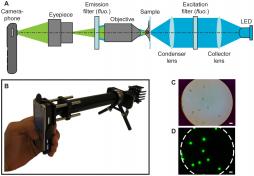A group of researchers from University of California at Berkeley and San Francisco have built a fascinating new device, which should make disease diagnosis in the field in the developing world a lot more feasible. The new device takes advantage of the recent penetration of mobile telephones in the remotest parts of the world – places where there are few health amenities, or even reliable roads and power.
Most mobile telephones today have built-in cameras which, although they may not be the dream of a professional photographer, can nevertheless produce digital images at sufficient resolution for diagnostic pathology. The researchers have combined a camera-equipped mobile phone with a simple light microscope, and packaged it into a simple, portable and rugged “diagnostic field microscope” (for technical details, please see here).
This contraption can not only take diagnostic images (e.g., from blood smears prepared from patients suspected to have malaria or sickle cell anemia), but can also transmit those images to trained pathologists anywhere in the globe for professional diagnosis. And all this can be achieved, logistics permitting, in real time. As anyone who has any experience of healthcare in the remotest parts of the developing world knows, this latter is really a make or break factor. In many places, the patient and his/her family may have travelled for days to get to a clinic. The probability that the patient can be sent home, and then be expected to return in a week for diagnosis and follow up treatment is next to nil. Thus, this device, if deployed in the field, can potentially increase the rate of treatment by very large proportions, and may in fact help control the spread of epidemics such as malaria, by timely administration of treatment to an initially infected cluster.
The researchers have gone one more step, and have equipped this system not only for bright-field microscopy (e.g., taking photographs of blood smears that can be done using ambient light), but also for fluorescence microscopy using an inexpensive LED (light emitting diode) as the illumination source. They have tested the feasibility of using fluorescence microscopy to diagnose Tuberculosis from sputum samples, stained with a fluorescent dye that helps in the identification of the tubercolusis-causing bacteria. They have also tested ways in which the images obtained can be processed automatically, and have confirmed that the phone computational resources are sufficient for such processing.
After this initial and very exciting report, it will be great to see a translation of this technology to the real world, wherein a company comes up with a business model that’ll ensure sustainable production and distribution of these mobile phone microscopes to places where they can really make a difference in the lives of people.
I would love to hear ideas about translation. Please post comments below.


Post new comment